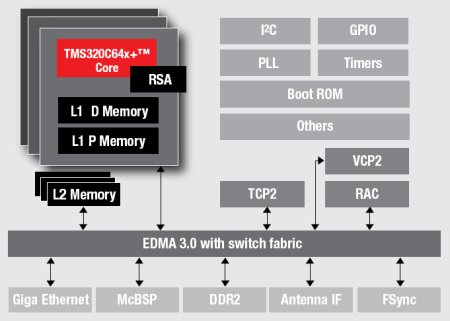Linux-based multicore design targets femtocells
Jun 24, 2010 — by Eric Brown — from the LinuxDevices Archive — 7 viewsTexas Instruments says it is developing devices for small-scale “femotocell” wireless base-stations, likely using its DSP-based TMS320TCI648x system-on-chip. TI is developing scalable devices that can support from eight to 64 users, and which incorporate an ARM processor, digital radio front end, and a Linux-ready reference design, says the company.
Texas Instruments (TI) does not name the system-on-chip (SoC) that will drive the designs except to refer to a recently announced multicore SoC, but the company points to a page that features its TMSTCI6489 processor. The company announced the TMS320TCI648x family of multicore digital signal processors (DSPs) a year ago.
The initial TCI6485 and TCI6489 models were said to power femotcells serving between eight and 32 HSPA 3G wireless users, respectively. At the time, TI said the DSPs were offered with a Linux support package and a software reference design from TI partners Continuous Computing and MimoOn. (See farther below for more on the TCI6489.)

TI femtocell basestation architecture
(Click to enlarge)
It is unclear whether the device will use a new, higher powered version of the TCI648x or whether the higher capacity is enabled through the addition of the ARM processor. Some of the language suggests that the ARM and DSP cores may be integrated on a single SoC or chipset.
The company also announced this week that it is joining cellular software vendor Azcom Technology and wireless development firm Nash Technologies "the industry's first live demonstration of a 32-user femtocell solution" at the Femtocells World Summit being held through today in London. Earlier this year, the three partners announced the availability of a 3GPP Release 6 and 7 compliant voice and data physical layer reference stack for UMTS femtocell products based on TI's SoC and PHY libraries.
TI says that that its femtocell-targeted SoCs are code-compatible with other TI DSPs designed for wireless macrocell, picocell, and femtocell infrastructure. The multicore femtocell solutions will also integrate a portfolio of TI analog solutions such as data converters, RF products, power management, clocks, and amplifiers, says the chipmaker.
The designs are said to use software defined radio (SDR), enabling a single femtocell product to simultaneously support the execution of two standards supporting deployments such as WCDMA and LTE. The product family will be compatible with all major 2G, 3G and 4G systems including GSM, CDMA, WCDMA, TD-SCDMA, WiMAX, FDD-LTE, and TDD-LTE, says TI.
The femotcell solutions will be offered with Linux support packages, "as well as other software solutions from TI third parties," says TI.
TCI648x background
Last June, TI announced both a residential-focused TCI6485 DSP equipped with dual C64x+ DSP cores clocked to 850MHz, as well as the 32-user TCI6489. The latter, which appears to drive TI's currently demonstrated 32-user femtocell design, offers a range of 200 meters and is designed for enterprise or "super femto" applications, said TI at the time. It is equipped with three of the same 850MHz C64x DSP cores, for a claimed 2.55GHz of performance.

TCI6489 block architecture
(Click to enlarge)

Virtualization implementation in TCI6489
(Click to enlarge)
Instead of implementing separate RISC processors, the TCI648x DSPs substitute a real-time virtualization capability created for the DSPs by VirtualLogix. As a result, a single chip can offer full ISO Layer 1 to Layer 3 support on a single device, claims TI.
The Linux kernel and the DSP/BIOS software kernel foundation can run side by side on one of the DSP cores "with negligible performance overhead" using the virtualization technology. This week's announcement, however, made no mention of virtualization. (For more on the TCI648x DSPs and the femtocell market in general, please see our earlier coverage, here.)
Stated Kathy Brown, GM of TI's wireless base station business, "We are leveraging expertise in multiple technologies across TI to offer a complete SoC requiring no external processors and seamless integration to single chip analog front ends. Our newest femtocell devices will deliver superior levels of performance coupled with extremely low power consumption and multi-user support."
Availability
Femtocell devices based on TI's new multicore SoC platform will begin sampling in the first half of 2011, says the company. More information may be found here.
TI is demonstrating "the industry's first live demonstration of a 32-user femtocell solution" today at the Femtocells World Summit in London, U.K., room #152.
This article was originally published on LinuxDevices.com and has been donated to the open source community by QuinStreet Inc. Please visit LinuxToday.com for up-to-date news and articles about Linux and open source.